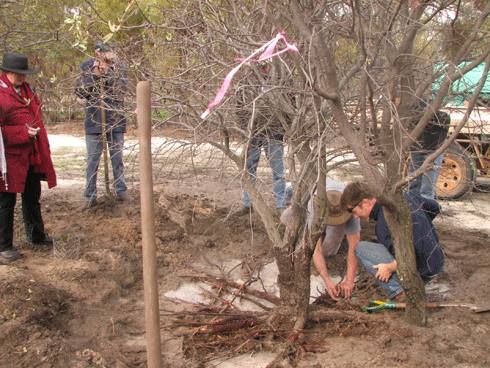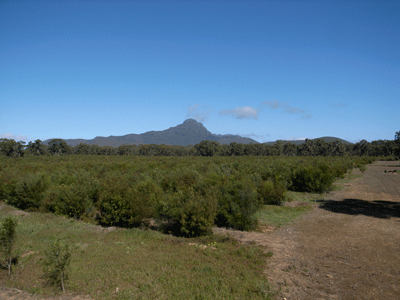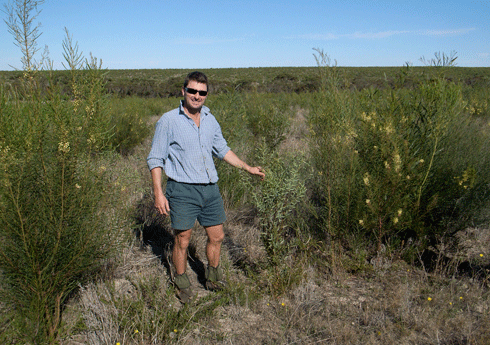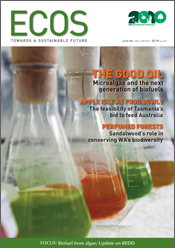
|
Published: 20 December 2010
Australian sandalwood comes of age
In the arid and semi-arid rangelands of Western Australia, where pressures on the landscape include increasing numbers of feral goats, the sustainability of the wild harvest of old-growth sandalwood (Santalum spicatum) is being questioned. But the sandalwood plantation industry – which has experienced significant growth in the past few years – is coming of age, and offers hope of a more ecologically supportive way of exploiting this valuable crop.
In Western Australia, Santalum spicatum, an endemic species of sandalwood, was a significant part of the local economy in the 19th and early 20th centuries. The trees were harvested in the wild and exported to Asia and the Dutch East Indies. Overexploitation and land clearing soon threatened the viability of the industry, and the government stepped in to protect the high-value crop with harvest and export controls.
By the 1990s, farmers in Western Australia were beginning to experiment with plantings of Santalum spicatum. Larger agribusiness players soon entered the fray in the Kimberley region, with irrigated plantations of Santalum album, an exotic species native to India.
By 2010, the Kimberley region was home to the largest sandalwood plantation in the world: ~3700 ha of Santalum album, managed by Tropical Forestry Services, an ASX-listed Western Australian company. In the low-to-medium annual rainfall (300–600 mm) regions of the Western Australian wheatbelt, Santalum spicatum is grown by farmers, conservation organisations and smaller agribusiness ventures, with a total area of ~10,000 ha under non-irrigated plantation.
Market opportunities
The sandalwood industry is at a critical juncture. The medium-to-large shrub matures slowly, taking several decades to produce quality oil-rich wood. Plantation sandalwood has not yet been harvested in Australia, but over the coming years, many plantations will be ready for harvest. This comes at a fortuitous time for growers and investors. For the past 18 years, the price of Indian sandalwood oil has risen by 20 per cent a year. Today, wild-harvested sandalwood fetches roughly $8000/tonne, with plantation Santalum spicatum fetching $3000–6000/tonne. Rising prices are driven by steadily increasing global demand, and because stocks of sandalwood in India – previously the dominant global supplier of sandalwood – are severely depleted, to the extent that sandalwood is threatened with extinction in some parts of the country. Sandalwood is probably best known for its use in joss sticks, which are burned as incense in Buddhist and Hindu religious ceremonies. Sandalwood oil is also used worldwide for perfume and the wood for decorative woodwork items.
While these market opportunities are undoubted drivers of the rapid growth in Australian sandalwood plantations, scientists, farmers and conservationists have a new appreciation of the ecological services provided by well designed and sensitively managed commercial plantings. Revegetation with perennial plants is a well established rehabilitation strategy to reduce soil salinity and erosion, a common problem in the Western Australian wheatbelt. But, lack of commercial return from land under rehabilitation limits uptake. Sandalwood, particularly the native Santalum spicatum, offers the promise of commercial returns on ecologically supportive production. While the timber is effectively ‘locked up’ for 20 years, the per hectare returns from sandalwood over 20 years are predicted to be significantly higher than for wheat.
Hosts and parasites
Sandalwood is a root ‘hemi–parasite’, which attaches its roots to nitrogen-fixing host species (such as acacias and allocasuarinas) and extracts water and nutrients from them. Conventional sandalwood establishment practice has been to ensure that host plants are well established saplings (1–2 years old) before sowing sandalwood seed, although growers are now experimenting with simultaneous seeding of host and parasite.
In the early days of the industry’s renaissance, conventional wisdom said the best results came from establishing sandalwood with only one host species, Acacia acuminata, which is endemic to Western Australia and common in the wheatbelt. However, farmers in the wheatbelt region – led by the active growers’ group Australian Sandalwood Network, formed in 2003 – have been quick to adopt new research in the field, which suggests that Santalum spicatum will successfully establish on a range of host species.
Using multiple host species has clear practical advantages for farmers. They have the opportunity to use diverse naturally recruiting host species, including casuarinas, which are suited to local soil types and climatic conditions; they can also hedge against the relatively short-lived nature of some acacias. The biodiversity benefits are also exciting both farmers and conservationists, as birds, insects and other species are potentially able to benefit from the increased habitat and foraging potential of native multi-species systems.
Research and revegetation
Dr Patrick Smith, an agricultural ecologist with CSIRO’s Ecosystem Sciences, is supervising a research project looking at the potential biodiversity benefits of sandalwood plantations in the dryland production landscapes of southern Australia, focusing on reptiles.1 He explains that much of the data on habitat resources under perennial revegetation in the dryland farming systems of the Western Australian wheatbelt has focused on birds.
‘Our project is focusing on reptiles, because they are one of the groups we know least about in terms of their response to revegetation of farmland,’ says Dr Smith. ‘Our early results show that the more mature and biodiverse sandalwood plantings have around the same diversity and abundance of insects as natural bush. Not surprisingly, a wide variety of reptiles are moving in to take advantage of this.’
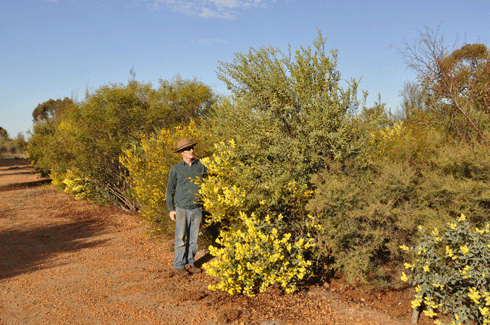
|
|
Dr Geoff Woodall on his family’s multi-species host plantation at Beaufort River, 250 km south-east of Perth. |
The University of Western Australia’s Centre of Excellence in Natural Resource Management has established dense, species-rich host plantations for Santalum spicatum as part of a study in the state’s south-west. A team of researchers led by Dr Geoff Woodall showed that individual Santalum spicatum plants have connections to, and can exploit, numerous host species.
‘Biodiverse sandalwood cultivation systems can be as productive or more productive, in term of sandalwood growth, as single host sandalwood plantations,’ Dr Woodall says.
|
The findings of Dr Woodall’s study have informed the Gondwana Sandalwood project in the south-west of Western Australia. Gondwana Link is a landscape-scale effort to restore and reconnect ecosystems across Australia’s only internationally recognised biodiversity hotspot. Extensive agricultural clearing in parts of this region has fragmented the landscape, but much of the bushland remains, and is being managed by Greening Australia and Bush Heritage Australia through purchases and conservation management. The completed link will be an arc of bushland stretching for 1000 km from the wet forests in the state’s far south-west to the edge of the Nullarbor Plain. |
The Gondwana Sandalwood project is part of the effort to reconnect the Stirling Range and Fitzgerald River national parks, currently separated by only 70 km of mainly cleared land. More than 250 ha of Santalum spicatum have been established on six Gondwana Link properties. The plantings on three of the properties, which are owned by Greening Australia, are being managed by Spicatum Resources Australia and will yield returns for investors. Plantations on the other three properties, which are private farms, are being undertaken with the assistance of the farmers and are co-funded by Greening Australia and Shell Development Australia (a philanthropic division of Shell that funds large-scale revegetation projects). |
‘For ecological restoration to get real traction at the scale required, we have to find new ways to harness commercial value from biodiverse revegetation,’ explains Mr Hamish Jolly, CEO of Greening Australia WA. ‘Greening Australia’s collaborative investments in sandalwood in Gondwana Link are about demonstrating that commercial sandalwood is a viable conduit to get large tracts of biodiverse bush back into degraded landscapes.’ |
Mr Ben Boxshall is proprietor of Spicatum Resources Australia, a ‘boutique’ agribusiness company that specialises in sandalwood agroforestry systems. He explains what drove him to set up Spicatum Resources, which established and manages the multi-species host Gondwana Sandalwood plantations (see box), in 2004.
‘Essentially, we saw we had a competitive advantage. At the time, most people were still using seedlings to establish the host system and were using mostly Acacia acuminata, sometimes experimenting with a second host. From my point of view, this was failing to adequately exploit the resources available.
‘We saw that we could cultivate sandalwood utilising a system of production that incorporates a large diversity and density (5000–10,000 host plants per hectare) of local plant species using the latest direct seeding technology. So, there was an opportunity to create a dense, diverse, productive and resilient system.’
In the farming enterprises in this highly variable rainfall region of Australia, resilience is a valuable asset. ‘If the sandalwood is not reliant on a single host, but instead is physically attached to and drawing on a large diversity of plants then the system is better equipped to keep functioning in response to hazards such as pests, pathogens and extreme climate events, or variations in climate,’ Mr Boxshall says.
Both Mr Boxshall and Dr Smith concede that research on the ecological value of multi-species host plantations is still in its infancy. But, as Mr Boxshall points out, ‘it’s not surprising to an ecologist that if you are using a suite of local native plant species and you’re creating a system that is dense, and taxonomically and structurally diverse (prostrate plants, ground covers, understorey and mid-level plants, and slower-growing larger overstorey plants), it will be good habitat for a wide range of species.’
More information
Australian Sandalwood network: tinyurl.com/sandalwood-network
Productive Perennials for Biodiversity (Future Farm CRC): tinyurl.com/perennial-biodiversity
Gondwana Link Sandalwood project: www.greeningaustralia.org.au/visionary-projects/gondwana-link
Sandalwood in agroforestry: www.agroforestry.net.au/main.asp?_=Sandalwood
Spicatum Resources Australia: www.spicatum.com.au
1 This research is being undertaken in conjunction with the Productive Perennials for Biodiversity program of the Future Farm Cooperative Research Centre, and is being conducted by University of Western Australia PhD student Frances Leng.


